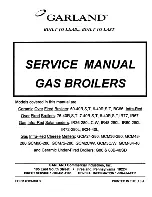
- 33 -
INSTALLATION
5 - HYDRAULIC CONNECTION
When the boiler is assembled on an old
installation, make sure that the installa-
tion is rinsed with fresh water, so as to
clear any sediment stagnating in areas
where the flow is slow.
To prevent circulation noises in an ins-
tallation featuring temperature controls,
the following is recommended:
- Do not fit all the radiators with tempe-
rature controls,
- Fit a differential valve,
In accordance with the decree of the Mi-
nistry of Health for the protection of the
drinking water supply, the filling system
must be fitted with a disconnecter of type
CB (non-controllable pressure zone).
Never position the isolation valve
between the safety control and the
hot water tank (THI 10-50 C + DHW pro-
duction system), never between the boi-
ler shell and the expansion vessel.
- Bleed:
The bleed of the circulating pump features a flexi-
ble tube that can be connected to the outlet (con-
densate extraction funnel).
- Safety control (for hot water production mo-
dels):
• The safety control must be installed at a
low point (0.25 m from the floor) in order to
enable the extraction of the domestic hot water
tank by siphoning. Otherwise, use a weld with
a low point drain tap.
• It is normal for the d.h.w. safety control to
leak a little water during the pre-heating of the
hot water tank. If the cold water pressure ex-
ceeds 4 bars, the installation of a pressure-re-
ducing valve on the cold water inlet is advised.
- Isolating valve:
It is recommended to place isolation valves on
the installation’s flow-returns in order to allow
possible servicing on the boiler without having to
drain the installation.
- Safety valve:
This must be connected to the used water drain
via a siphon funnel.
- Condensate outlet:
The condensate outlet must be connected to an
accessible siphon.
- Header
A header must imperatively equipped the installa-
tion.
- Expansion vessel:
The correct operation of the boiler requires an
installation pressure of at least 1 bar.
If the installation is a renovation and uses an
open tank, this must be removed and replaced
with a closed tank to seal the circuit.
The expansion vessel must be sized properly to
guarantee the longevity of the installation. The
vessel should be able to support an expansion of
6% of the total water capacity of the heating cir-
cuits. But it is important to note, in order to gua-
rantee this expansion, that the useful capacity of
a vessel does not equal its actual capacity.
Example:
• Installation: 100 litres
• Domestic hot water tank: 5 litres
• Boiler: 3,8 litres
• Total water capacity: 108,8 litres
Conditions
: Using a vessel pre-loaded to 1 bar
(under floor boiler = ground floor
h 1 floor), heating safety
valve calibrated at 3 bars, installa-
tion filled cold at 1 bar.
• Vessel efficiency calculation (R):
+ 1) = the transformation of relative pressures into
abolute pressures
5.1 -
R
ecommendations
5.2 - Accessories to connect, install or
adjust
!
R
Safety Pressure - Filling pressure
(
)
Safety Pressure
------------------------------------------------------------------------------------
=
R
3 1
+
(
)
1 1
+
(
)
–
3 1
+
(
)
----------------------------------------
0 5
,
=
=
Summary of Contents for THI 10-50c
Page 61: ... 64 XII NOMENCLATURE THRi 10 50 C ...
Page 64: ... 67 NOMENCLATURE CONTROL BOX ...
Page 66: ... 69 NOTES ...
















































